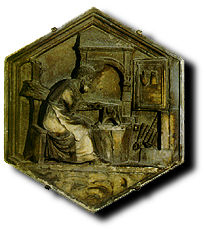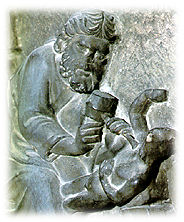by
Cinzia Dugo
The social position of the artist in the 14th century
The profession of the artist has not always had the same importance over
the centuries. Nowadays, when an artist manages to make his name and obtain
a certain amount of recognition, it means that his activity will not only
allow him to enjoy a very comfortable economic position, but that he will
also gain a series of moral and social privileges. We live in very different
times from those of the 14th century, which were instead characterized by
the presence of a great many famous old masters Giotto, Simone Martini,
Ambrogio and Pietro Lorenzetti) who, in spite of having paved the way for
the art of the Renaissance, enjoyed
far fewer privileges than the artists of today.

Andrea Pisano - The art of the blacksmith
|
First of all, we should perhaps explain that in the 14th century
all artistic activities were carried out in the workshop; this was usually
composed of one single room or several rooms, often the property of religious
communities (churches and convents) but, as a general rule, it was part
of the house of the owner of the workshop. This information already gives
us an idea of the close relationship between art and crafts, a dual concept
that has, for a long time now, appeared to have given way to an artistic
system that frequently and with various difficulties is forced to have
work carried out by people who are simply the heads of limited businesses:
carpenters, smiths, builders, stone cutters, etc. What is the reason behind
this interruption of the fusion between these two activities? It may,
perhaps, be due to changes in the attribution of values. Now, in fact,
while the artist seems to give more importance to the idea and design
behind his work, and almost to fear that he may contaminate his category
by using manual skills, the craftsman does not think of his trade as being
in any way connected with real art and certainly nothing like what is
often only the presumed work of some of the most fashionable artistic
figures of the moment.

Andrea Pisano - Sculpture (detail)
|
During the Trecento, however, budding artists had to follow an apprenticeship;
this meant being accepted in one of the workshops, where they had to learn
to put into practice all that the master could patiently and perseveringly
teach them. One of the apprentice's first tasks was to grind and pound
the pigments, boil up the glues, grind up plaster and spread it on the
wooden panels as a foundation for the painting that was to be applied.
The young apprentice was not allowed to do any actual painting until much
later on, and even this was at first limited to learning how to draw,
copying other works or preparing the gold leaf that was applied to the
finished panels. This period of apprenticeship lasted from three to six
years and, in some cases, students also had to pay the master a fee because,
apart from teaching him a profession, he also provided him with board
ad lodging. Artists, like anyone else who carried out some sort of trade,
were also obliged to enroll in one of the ***guilds***. The Florentine
painters belonged, for example, to the Guild or Arte of Doctors, Herbalists
and Haberdashers, while sculptors were members of the less important corporation
of builders and carpenters. Although all the painters belonged to one
of the richest and best known associations, this did not, in actual fact,
mean that they had any particular privileges: they were not allowed to
hold any of the important positions in the guild or obtain prizes for
special technical services because they were always dependent on others
for their work. The only way they could emerge from anonymity and obtain
recognition was through private patronage. Artists frequently had to sollicit
the interest of high ranking personalities, creating works of art that
usually had in some way to represent and promote the social 'status' of
the recipients. Here again the artist was limited, oppressed by the mentality
of the late Middle Ages that was opposed to giving a more dignified recognition
to his category, as he had to be careful to satisfy all the requirements
of his customer, who decided on the shape, size and colours of the commissioned
work. The so-called masters formed an association, called the company
of St. Luke, to try and free themselves from this subordinate condition;
it was a separate entity from the city guilds and included painters, sculptors,
illustrators of manuscripts and glass makers. This attempt to ennoble
an artistic activity eventually turned out to have been made in vain,
for it was not to acquire any particular individuality until two centuries
later. The situation today is very different from the late Middle Ages
and yet, the Trecento, in spite of the lack of social recognition for
its artists, can be considered a particularly prolific century from the
artistic and literary point of view. Perhaps a little more humility and
a renewed desire to unite artistic ability with the no less inferior skills
of craftsmen could possibly lead to priceless works of art being produced
again, as they were during the far off and fascinating years of the 14th
century.
in collaboration with:

|



